USNS Apalachicola (T-EPF-13) is an autonomous transport vessel for the US Navy
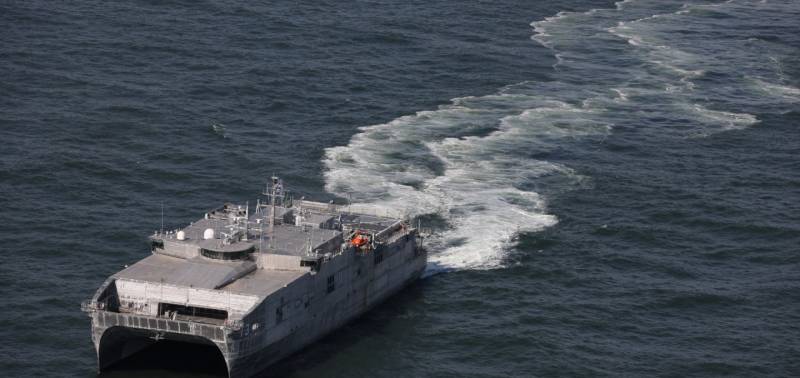
USNS Apalachicola (T-EPF-13) on sea trials, 2022
Since 2010, in the interests of the US Navy, "expeditionary fast transports" (Expeditionary Fast Transport - EPF) of the Spearhead project have been built. In mid-February, the fleet received another vessel of this type. The new high-speed catamaran USNS Apalachicola (T-EPF-13) is similar to the previous vessels of the series, but received a different control system. It has several modes of operation and is able to simplify the service of the crew or operate autonomously.
Another transport
In 2010-20 Austal USA built and handed over to the US Navy 12 high-speed catamaran transports of the Spearhead type. The new ship Apalachicola is the 13th and completes the first series of Flight I. As it became known later, the last pennant of the series was planned to be built according to a revised project. The main changes affected the ship control complex.
USNS Apalachicola (T-EPF-13) was laid down in January 2021 at the Austal USA plant in Mobile, Alabama. Construction on the slipway continued until November, after which the ceremony of "baptism" and launching took place. In 2022, the completed catamaran was sent for sea trials. Over the past few months, he went to sea several times and performed various tasks, showing characteristics and various capabilities. Particular attention was paid to the new control complex.
Based on the results of sea trials, the transport vessel was accepted into service. The solemn ceremony of handing over USNS Apalachicola (T-EPF-13) to the customer took place on February 16 in the port of Mobile. In the near future, the vessel will enter full operation and begin to solve its tasks.
Like other Spearhead ships, the new Apalachicola was transferred to the Naval Sealift Command. The catamarans of this project are used in the interests of the Marine Corps and are responsible for the transportation of personnel, equipment, weapons and various cargoes. High speed and considerable cruising range provide significant advantages in the context of the rapid transfer and deployment of marines.
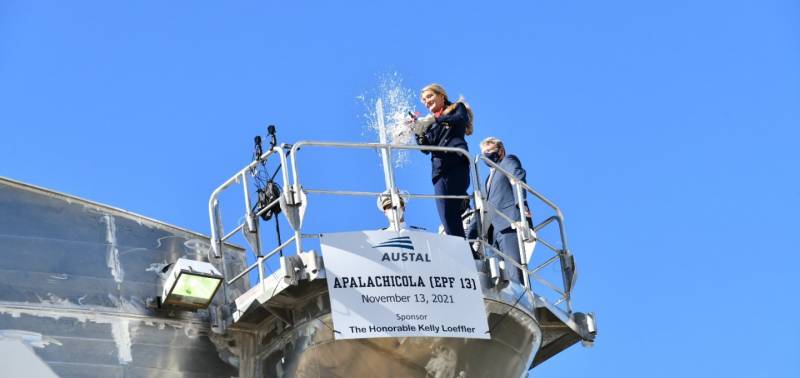
Baptism of the ship "Apalachicola", November 2021
In the official announcement of the transfer of the new transport, Austal USA drew attention to its main features. The main innovation of the modified Spearhead project is the original control system with autonomous operation. USNS Apalachicola (T-EPF-13) will be able to stay at sea and perform tasks without human intervention for up to 30 days. The unmanned regime is expected to further improve the vessel's operational capabilities.
Technical features
The original Spearhead project provides for the construction of a catamaran vessel with a length of 103 m and a width of 28,5 m. The displacement is more than 1,5 thousand tons. The main structures are made of aluminum alloy, which reduces their weight and has a positive effect on driving characteristics.
Spearhead has a distinctive appearance, due to the purpose of the vessel and the optimization of the design. So, the bridge of the catamaran, connecting the two hulls, is made in the form of a large box of the maximum possible volume. Such a superstructure accommodates cabins for passengers and areas for accommodating equipment or cargo. A small cabin is placed on top of the superstructure. There is a heliport in the stern.
Four diesel engines MTU 20V8000 M71L with a power of 12205 hp are placed in the side hulls of the vessel. and gearboxes ZF 60000NR2H. The design of the vessel and the power plant provide a maximum speed of 43 knots. Cruising range at economic speed - 1200 nautical miles.
Inside the superstructure there are quarters and cabins for 45 crew members. A spacious cabin is provided to accommodate the troops / passengers. On a long voyage, 104 beds are organized in it; for short-term flights, lying places are replaced by 312 chairs. A supply of provisions is provided on board: 104 passengers will use it up in 14 days, 312 in 4 days.
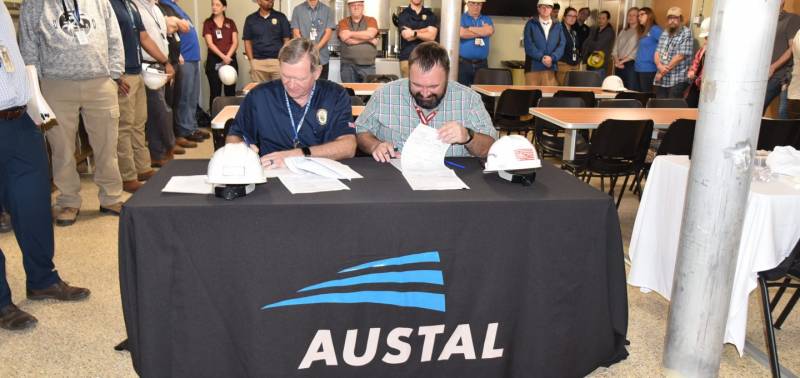
Signing of the act of acceptance and transfer of the vessel, February 2023
For cargo, a covered deck with a total area of approx. 1900 sq.m. It provides for the placement of any equipment, including Tanks, various cargoes, etc. It is possible to deploy a modular hospital or other special complexes. The total carrying capacity is 600 tons. Loading of equipment is carried out on its own through a folding aft ramp with a carrying capacity of 100 tons.
Transport carries the minimum necessary weapons - 4 heavy machine guns for self-defense. A helicopter of one of the standard types for the US Navy is located on the aft platform. The ship USNS Apalachicola, made according to the updated project, for the first time in the series can take the V-22 tiltrotor. The use of rigid-hull inflatable boats is envisaged.
Offline mode
The original Spearhead design calls for a standard set of control systems and other equipment. Crew of 40-45 people. controls the operation of systems, carries out navigation and driving. Most of the operations are performed from the central post. Electronic weapons include surveillance radar, satellite navigation, communications systems, etc.
For the next Apalachicola transport, Austal USA, together with L3Harris and General Dynamics Mission Systems, has developed a new control complex. Its main element was the "machine control system" Machinery Control System (MCS) from "Austal". Some other devices have also been introduced. The new control complex is integrated into the general ship systems and controls their work.
Updated ship controls have several modes of operation. The first one provides automation of the maximum number of processes. The complex independently monitors the operation of units and devices, maintains the required indicators, etc. Due to this, the load on the crew is reduced and it becomes possible to reduce it.
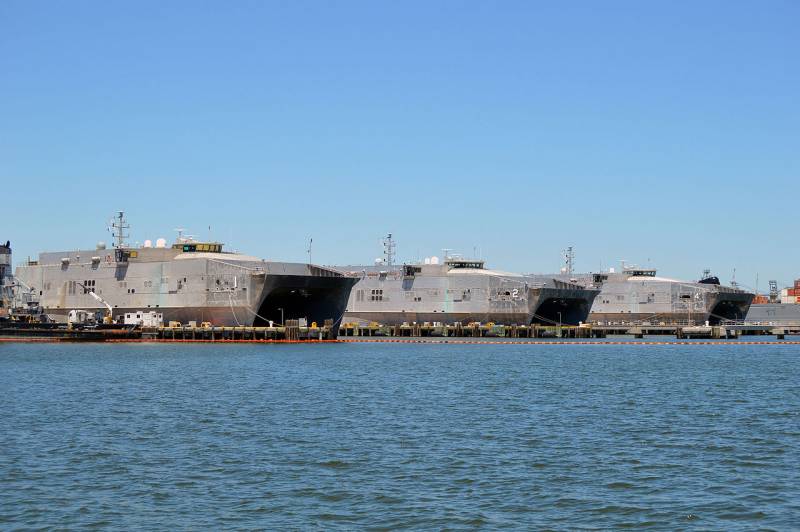
First Spearhead-class ships, 2015
It also provides a completely offline mode. In this case, the transport works as an unmanned vessel. Automation is able to lead it along a given route and respond to changes in the situation, as well as perform some other simple tasks and maintain communication with a remote operator. In the absence of people on board, the transport can remain at sea for up to 30 days.
Autonomous operation has been carefully tested in recent sea trials. The control complex showed its best side, and the ship equipped with it was accepted by the customer. It appears that Sealift Command will take full advantage of the new capabilities.
New opportunities
High-speed transports "Spearhead" are designed for the rapid transportation of people, equipment and goods over long distances. The high travel speed provides certain advantages, although for the sake of it it was necessary to sacrifice the carrying capacity and capacity. In these parameters, catamarans are inferior to the "ordinary" transport vessels of the US Navy.
The latest USNS Apalachicola transport in the series (T-EPF-13) retains the same performance characteristics and can also provide fast transportation. At the same time, he got the opportunity to work with a reduced crew or without it at all. It is assumed that such modes will also find application in solving various problems.
It can be assumed that the new vessel will be used mainly as a platform for experiments. Without a crew in the wheelhouse, it will carry various cargoes, incl. in real missions. Due to such operation, the Navy will gain the necessary experience, look for potential problems, etc.
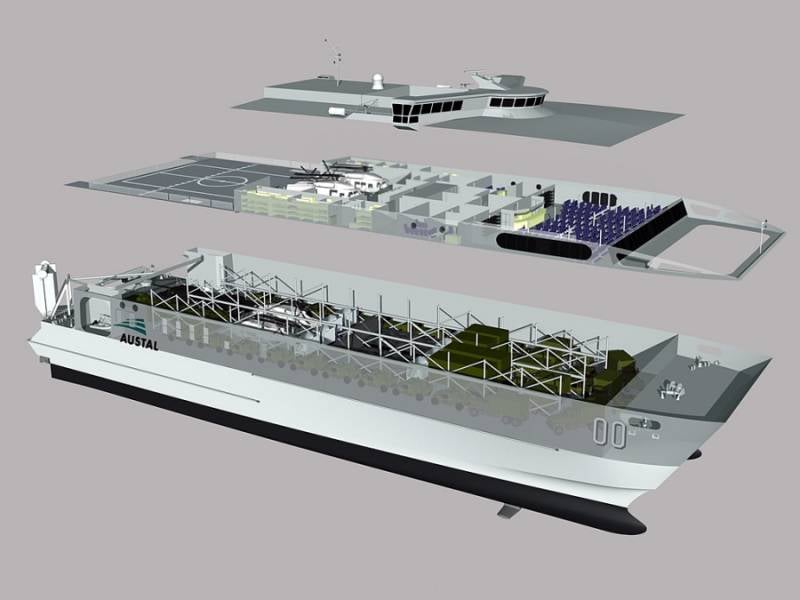
The layout of the internal volumes of the vessel
Attention should be paid to the fact that the USNS Apalachicola is now the largest unmanned vessel in the US Navy. It has already shown the fundamental possibility of using autonomous control systems on platforms of this dimension. In addition, with its help it will be possible to gain experience for the further development of the unmanned direction in the context of large and heavy vessels.
With all this, Apalachicola retains all standard equipment and original transport capabilities. If the need arises, the catamaran will be able to take passengers and cargo on board, and, under the control of a full crew, go to a given port - like other Spearhead ships without a special control complex.
Developments and their application
To date, the US Navy has received 13 Spearhead high-speed catamaran transports built as part of the first Flight I series. . One more transport is under construction, one is contracted and three are planned to be ordered in the foreseeable future.
There is reason to believe that the current experiments with the Apalachicola ship are related to the further development of the Spearhead project. The following transports of this type may receive a similar control complex and corresponding technical and operational capabilities. In addition, Austal USA and its subcontractors can use the developments of this project to create other vessels and ships of medium and large displacement.
The customer and contractor have not yet specified whether it is planned to build new autonomous catamarans. However, the answer to this question may appear in the near future. While maintaining the current pace of work, the next Cody ship will be transferred to the Navy next autumn or winter. And it is unlikely that shipbuilders and the fleet will hide the advantages and special capabilities of this transport.
Information